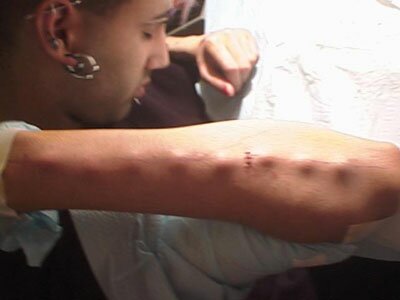Implants are created by placing an object under the skin to make a design. The procedure involves making an incision near the area the implant will be placed, then a pocket is made and the object is inserted. The incision is then stitched up and it’s all done.

(Star implants inserted in the front of the head)
Steve Haworth is a pioneer and expert in the art of 3-D body modification. When asked, in an interview what motivates people to get the implants, Steve replied, “Extreme individualism. Ten years ago if you had a piercing or a tattoo you stood alone, and today, even though piercing and tattooing are still a wonderful form of self-expression, you stand in a group.”

(Marking the implant area before making the incision)
Titanium, soft solid silicone, and Teflon are all commonly used materials. The procedure itself is quite safe, but as with any sort of body modification, there are some risks.

(Opening the implant incision)
Aside from ensuring the equipment is steralised using an autoclave, there is not much else that can be done to eliminate the risks associated with inserting objects under the skin. On occasions, the materials used can become rejected by the body and an allergic reaction can occur. An example is stainless steel.

(Inserting the implant)
But, if the right material is used and a professional does the procedure, it is very rare that the body will reject it. If rejection does occur, the body will push the implant out through the skin.

(Implant procedure completed)
Another serious risk is hitting nerves while making the incision or inserting the object. “There’s a lot of areas in the sides of the head near the temple and the cheek area that I will not work on because there are nerve channels that run in those areas that control muscle function,” Steve said. “I’m really, really, really apprehensive about doing work on the back of the hand,” Steve adds, as there is the risk of possible loss of sensation to some of the tissue.
Once the procedure is finished, sometimes the object will shift slightly from it’s original position and that’s completely normal. However, if the customer is careless and doesn’t take proper care, the object can shift severely and in turn change the look of the design.

(Finished implant procedure)
The length of time the process takes depends on the type of implants and the person it is being done on. Each person’s fibrous layer is different; some may take less than 10 minutes, others up to half an hour. It also depends on the size of the implant.
The implants are meant to be permanent but the can be removed. In fact it’s easier to remove them than it is to put them in. If someone isn’t happy with the outcome, or if they’ve shifted at all, they can easily be removed or replaced.
As far as reversal is concerned, implants can be removed at a later date the same way they were inserted. The beauty of implants is that they can be temporary, exchangable or permanent.
Some people will go to great extremes to stand out in a crowd however they receive mixed reactions. Some people this the implants look very cool and extreme, however others view the procedure as a form of mutilation. Some suggest implants are just a “sign” to get attention.

(Chest implant on female)
Like with any form of art, whether it be on the human body or hanging on a wall, it all comes down to personal preference, some people like it and some don’t.